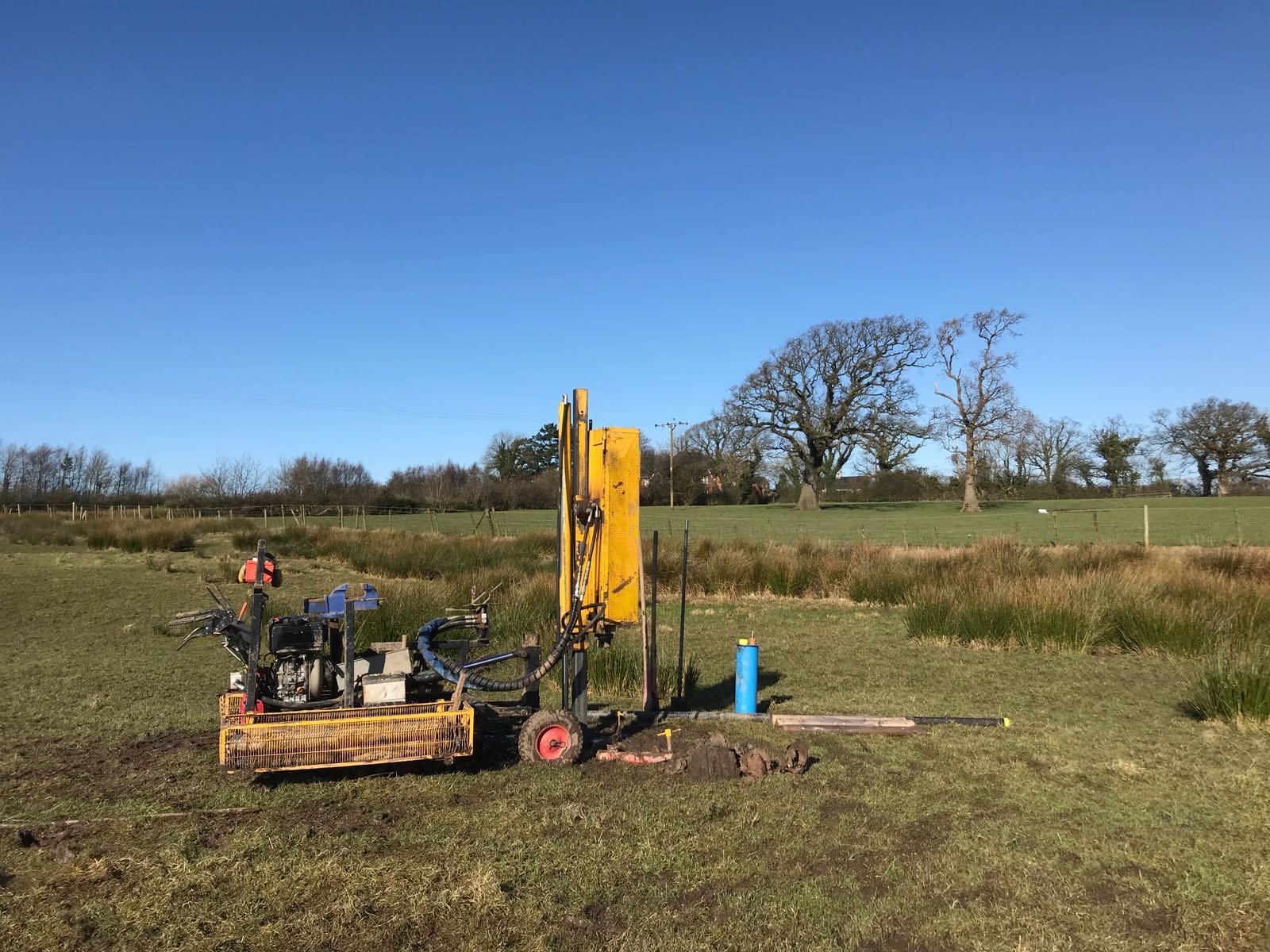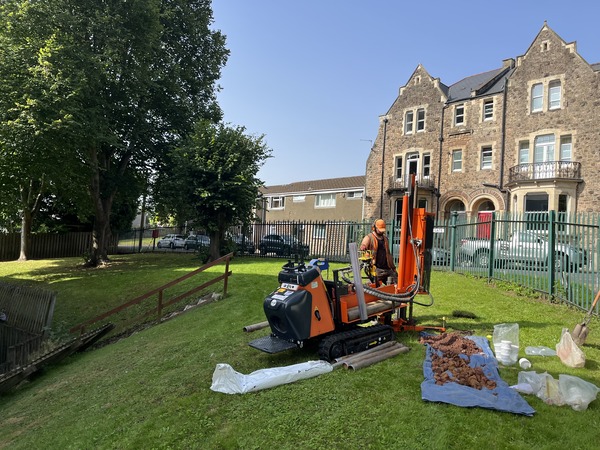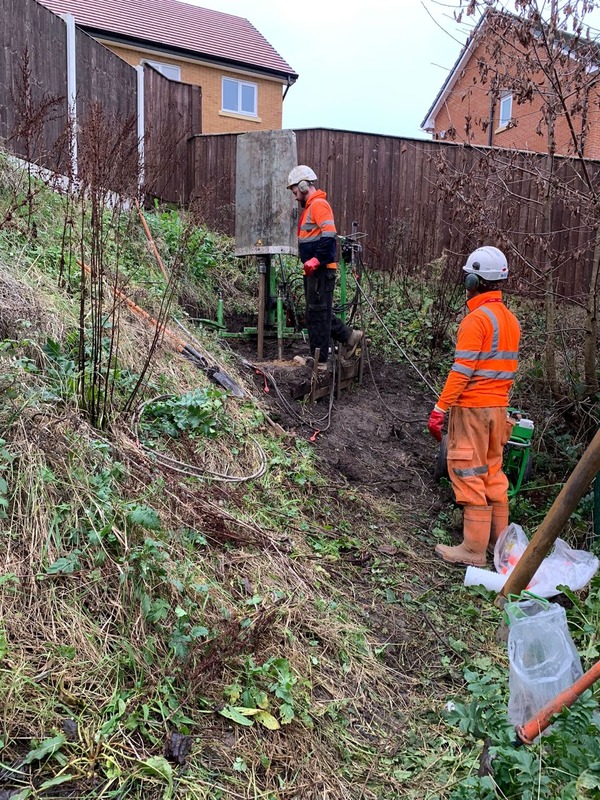
Window Sampling, also known as Windowless Sampling, Dynamic Sampling or Mini Boreholes, is a cost-effective and efficient site investigation technique for assessing shallow ground conditions in geotechnical and environmental investigations.
Sub Surface provides Window Sampling services as part of ground investigations across Great Britain. Our services deliver valuable information on ground conditions and soil parameters, enabling expert recommendations for various geotechnical and geo-environmental aspects, including foundation assessments, contamination analysis, ground gas risk assessments, etc.
Get in touch with your local Sub Surface office today to request a quote for Window Sampling as part of your ground investigation.
What is Window Sampling?
Window Sampling is a cost-effective drilling method commonly used for shallow geotechnical and environmental investigations. It is generally suitable for cohesive strata and some sands.
The traditional Window Sampler is a relatively lightweight, compact, and mobile rig mounted on rubber tracks, allowing easy access on and off site. Due to its speed and mobility, Window Sampling is ideal for sampling multiple positions in a single day with minimal disturbance.
Modular Window Sampling rigs can be used on sites with restricted access, such as in buildings, basements, gardens, or on slopes.
The difference between window sampling and windowless sampling is minimal. A window sampling tube contains a slot or “window” along its side, allowing direct soil examination, whereas windowless sampling collects relatively undisturbed samples in a sealed tube.
Window Sampling is typically not suitable in gravel or rock, and alternative techniques such as cable percussive or rotary drilling may be more appropriate.
Common Types of Window Sampling Drilling Rigs
We use a range of window sampling drilling rigs at Sub Surface. Our Contract Managers can advise on the most suitable rig based on factors such as access, space limitations and the known geology of the site.
1. Tracked Window Sampling Drilling Rig
A tracked window sampling rig is the most commonly used drilling rig in the Ground Investigation industry. The rigs are designed to be compact and mounted on rubber tracks, making them relatively easy to manoeuvre around site. They can be used on sites with restricted spaces, track across difficult terrain and through tight spaces, causing very little disturbance to the ground.
The tracked Window sampling rig can drill to depths of up to 10m in favourable ground conditions, but generally between 4m and 6m.
|
Typical Window Sampler Rig Dimensions: |
|
|
Length: |
2600-2729mm in transport mode, 2760-2950mm in sampling mode |
|
Height: |
1450-1490mm in transport mode, 2200-3100mm in sampling mode |
|
Width: |
600mm to 1220mm in transport mode, 1170-1248mm in sampling mode. The lightweight rigs have a 600mm width to fit through doorways. |
The Window Sampler dimensions are approximate and can vary depending on the brand and model. All dimensions should be confirmed prior to arrival on site should there be restricted access.
2. Lightweight Modular Sampling Rig – LMSR and Electric LMSR
An LMSR (Lightweight Modular Sampling Rig) is highly manoeuvrable and portable rig, designed for sites with limited access and low headroom. The LMSR can be broken down into small manageable parts, carried or wheeled on to site and built at each borehole location.
The petrol powered LMSR is often used where a tracked rig cannot gain access such as on narrow tracks, embankments, slopes and limited access working areas. The petrol-powered hydraulic pack can be swapped out for an electric power pack, making it ideal for internal areas, confined spaces or sensitive areas.
The LMSR rig can drill to depths of up to 10m in favourable ground conditions, but generally to depths of between 4m and 6m
The dimensions of the most commonly used LMSR are: 1.20m Length x 1.00m Width x 2.00m Height. LMSR-H Specification. There are various models and brands of modular drilling rigs so always check the dimensions if there are access restrictions.
3. Handheld Window Sampling Rig
The Handheld Window Sampling rig consists of a hydraulic breaker attached to window sampling tubes. These are driven into the ground and extracted using hydraulic jacks.
Handheld window sampling is typically used for shallow investigations in very confined spaces where a rig is unable to access. However, in-situ testing (SPTs, dynamic probing) and casing cannot be used with this method.
The Handheld Window Sampling rig can drill to depths of 5m in favourable ground conditions.
4. Rotary Auger Rig
A Premier 110 Window Sampling Rig can be converted into a Rotary Auger Drilling Rig, capable of reaching depths of up to 25m. This makes it ideal for sites with restricted access that still require deep drilling.
The rig can perform SPT/CPT tests, collect UT100 and U100 samples, and is equipped with a special casing system to drill through gravels and seal off water inflows. However, its limitations include sampling quality and accuracy in detecting strata changes.
Therefore, we recommend using the Rotary Auger Drilling Rig only when no alternative methods are available.
There are various other types of Window Sampling drilling rigs. Contact your local Sub Surface Contracts Manager who will be able to advise on the most suitable drilling rig for your project.
Typical Steps in a Window Sampling Site Investigation
1.Site Preparation: The site is carefully assessed, a suitable drilling rig is chosen, and borehole locations are selected. A site visit can be undertaken, if required.
2. Percussive Drilling: The window sampling rig is mobilised to site and drilling commences. The sampler uses 1m long extension rods and is driven into the ground by a percussion method using a drop hammer. 1m long plastic-lined core samples are obtained to a depth of up to 10m in suitable conditions (typically around 6m), creating a full soil profile.
3. In-situ Testing: The Window Sampler is also capable of carrying out in-situ testing within the Mini Boreholes. The ground bearing capacity can be determined from Standard Penetrations Tests (SPTs) and Cone Penetration Tests (CPTS) using the drop hammer. Dynamic Probe Testing can also be carried out for ground profiling and assessing the risk of solution features.
4. Sample Extraction: Core, bulk and jar samples will be taken for testing and for our experienced Geotechnical and Geo-Environmental Engineers to log in accordance with British Standards (BS EN ISO 14688-1 and BS EN ISO 14689-1).
5. Analysis and Testing: Samples are taken for Laboratory Testing and/or Contamination Testing in order to determine geotechnical properties and carry out contaminated land risk assessments.
6. Borehole Backfilling: The boreholes are backfilled and reinstated or, if required, standpipes can be installed for Gas Monitoring and/or Groundwater Monitoring.
7. Written Report: Our expert Geotechnical and Geo-Environmental Engineers collate, analyse and interpret the data and produce a comprehensive written report.
How is Window Sampling used in Site Investigation?
Window Sampling is undertaken for a variety of purposes within Site Investigations, including:
- Soil profiling: Window sampling is used to understand the ground conditions and assess the stratigraphy of a site.
- Foundation Design: By logging and sampling subsurface conditions our engineers can determine the most appropriate foundation design. In-situ tests such as Standard Penetration Tests (SPTs) are used to assess ground bearing capacity and samples can be obtained for geotechnical testing.
- Contamination Assessment: Window Sampling enables the collection of soil samples at depth for contaminated land assessments. Groundwater samples can also be obtained to assess potential groundwater contamination risks.
- Gas and Groundwater Monitoring: Gas and groundwater monitoring pipes are installed into mini boreholes and subsequent measurements are taken to assess groundwater conditions and assess risks from ground gas.
- In-situ testing: Window Sampling rigs are capable of carrying out in situ testing to evaluate ground conditions, including Standard Penetration Tests (SPTs), Cone Penetration Tests (CPTs) and Dynamic Probing.
Request a Quote
If you would like a quote for Window Sampling as part of your Site Investigation or have any questions, please contact your local Sub Surface Office.
Other Ground Investigation Methods: Cable Percussive Boreholes, Rotary Drilling, Dynamic Probing, Trial Pits
Window Sampling FAQs
A window sampling tube has a side slot or “window,” allowing for direct soil examination. In contrast, windowless sampling collects relatively undisturbed soil samples within a sealed tube, preserving their integrity for analysis.
The number of window sampling boreholes which can be completed in one day depends on the type of rig, the depth and the ground conditions, but typically:
- Tracked Window Sampling: up to 6 boreholes to depths of 4 to 6m
- LMSR and Electric LMSR: 2 or 3 boreholes to depths of 4 to 6m
Typical noise of a window sampler at a 10m distance are as follows:
- 71.4 dBA – Average noise whilst idling
- 74.3 dBA – Average noise during sampling
- 94 dBA – Peak noise during sampling
The average noise during window sampling is generally comparable to typical noise levels on a construction site.
No, typically window sampling cannot reach the depths required for piling. We recommend Cable Percussive Boreholes or Rotary Boreholes are conducted for pile foundations.










